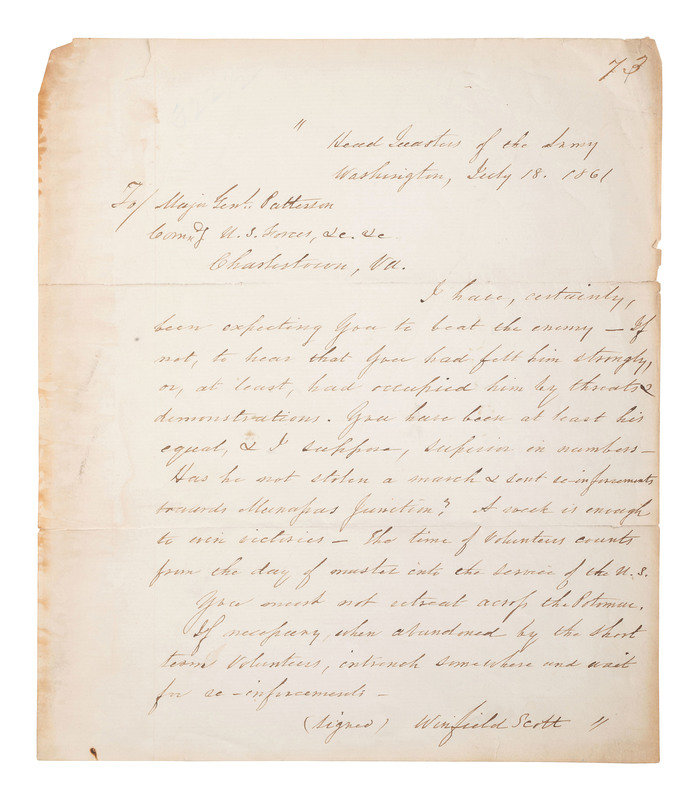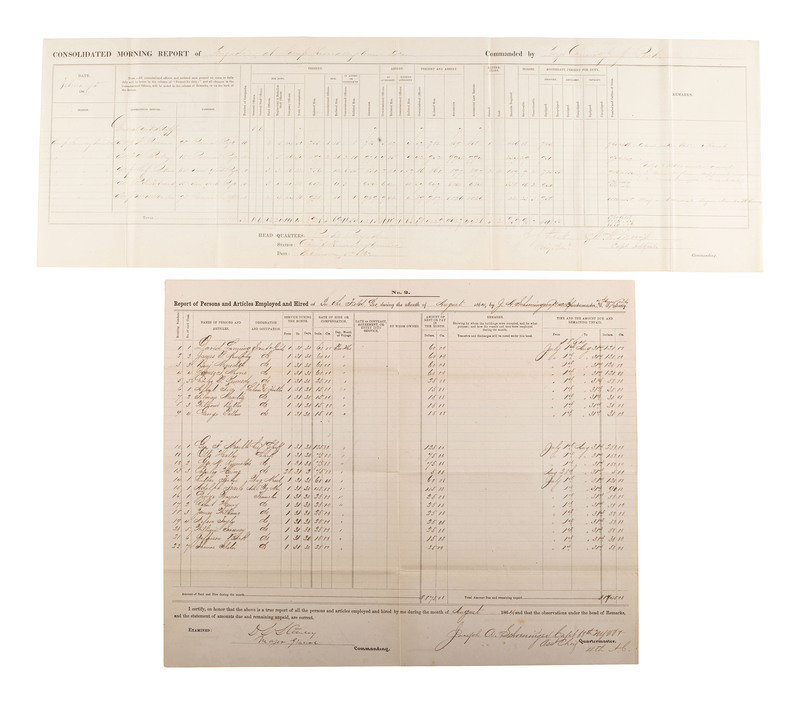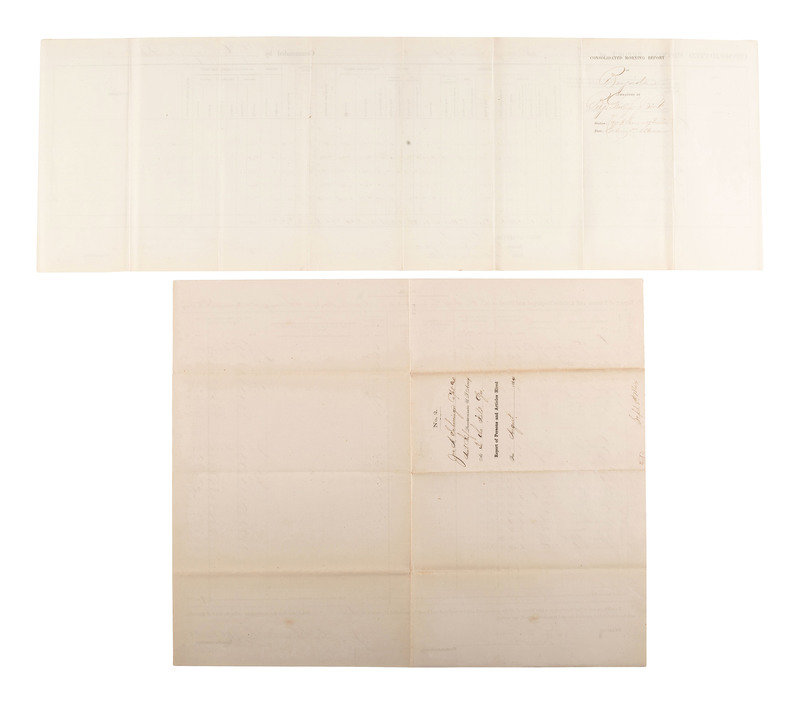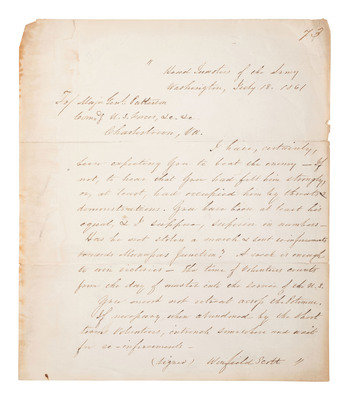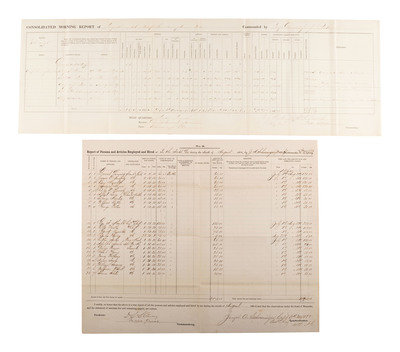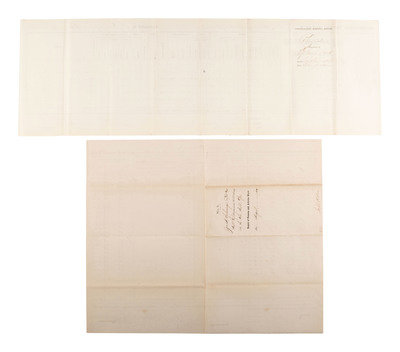Lot 799
[CIVIL WAR]. A group of 3 war-date documents and letters issued or signed by Union Generals Winfield Scott, William H. Morris, and David L. Stanley.
Sale 1096 - American Historical Ephemera & Photography
Lots Open
Nov 11, 2022
Lots Close
Nov 21, 2022
Timed Online / Cincinnati
Own a similar item?
Estimate
$300 -
500
Lot Description
[CIVIL WAR]. A group of 3 war-date documents and letters issued or signed by Union Generals Winfield Scott, William H. Morris, and David L. Stanley.
Original file copy of a letter from General Winfield Scott, “Head Quarters of the Army, Washington, July 18, 1861,” addressed to “Major Genl. Patterson, Comndg. U.S. Forces, etc. etc. Charlestown, Va.” 1p, 8 x 9 1/4 in. (creasing, tears along folds, toning). Scott admonishes Patterson for not vigorously pursuing the enemy: "I have, certainly, been expecting you to beat the enemy - if not, to hear that you had felt him strongly, or at least, had occupied hum by threats & demonstrations. You have been at least his equal, and I suppose, superior in numbers - Has he not stolen a march & sent re-informcements towards Manassas Junction? A week is enough to win victories ... you must not retreat across the Potomac...."
Major General Robert Patterson (1792 –1881) had been commissioned a major general of volunteers at the outbreak of the Mexican–American War and commanded the 2nd Division, Army of Occupation, during the Tampico Expedition. He saw action during the Siege of Veracruz and at the Battle of Cerro Gordo, where he was wounded. In 1861 he was appointed Major General of Pennsylvania volunteers and commanded the Army of the Shenandoah. General-in-Chief of the Army Winfield Scott gave Patterson vague orders to retake Harpers Ferry. Patterson failed to immediately act on these orders, was outmaneuvered after the Battle of Hoke's Run, and a Confederate army at Winchester under Brig. Genl. Joseph E. Johnston was able to march without interference to reinforce the Confederates under P.G.T. Beauregard at the First Battle of Bull Run. Patterson, widely criticized for his failure to contain the enemy forces, was mustered out of the Army in late July 1861.
[With:] Partly printed "Consolidated Morning Report of Bragade at Camp Tennalytown, DC Commanded by Brig. General J.J. Peck." 1p, 26 x 8 1/2 in. (creases at folds, ink fading but legible). Report of Peck’s brigade for 5 February 1862, including officers and men of the 15th, 95th and 98th Pennsylvania Volunteer Infantry and the 55th and 62nd New York Volunteer Infantry. Total of 152 officers and 3826 men present for duty. With signature of Peck by Adjutant Captain William H. Morris. Includes report of “Number and Calibre of Guns:” 1700 Cal .58, 1006 Cal .54 and 1550 Cal .69.
Brigadier General John J. Peck was commissioned as brigadier general of volunteers on August 9, 1861, he was given command of a brigade defending Chain Bridge and the Northern defenses of Washington at Tennallytown and soon after joined George B. McClellan's Army of the Potomac in Virginia. He commanded the 3rd Brigade, (55th NY, 62d NY, 93d Pa, 98th Pa & 102Pa) Couch's 1st Division, Keyes' IV Corps during the Pennsylvania Campaign. He served in the siege of Yorktown, and distinguished himself in the battles of Williamsburg and Fair Oaks. He was placed in command of the 2nd Division, IV Corps during the Seven Days Battles where he again distinguished himself. On July 25, 1862 he was promoted to major general of volunteers to rank from July 4, 1862 for his services in the Battle of Malvern Hill. William H. Morris (1827-1900) attended the United States Military Academy at West Point and graduated 27th out of 42 cadets in the class of 1851. Morris served at Fort Yuma, California. He resigned his commission in 1854. Morris and Charles L. Brown invented an improved firearm with a conical cylinder holding 8 cartridges which was patented in 1860. In August, 1861, Morris returned to the Army as a captain of volunteers on the staff of Brigadier General John J. Peck. He served with Peck's brigade during the Peninsula Campaign and from June 24, 1862 to September 1, 1862 as assistant adjutant general of Division 2, IV Corps, Army of the Potomac, after Peck was appointed commander of the division.
[Also with:] Partly printed “Report of Persons and Articles Employed and Hired, In the Field, Georgia, during the Month of August 1864.” 1p, 17 x 13 3/4 in. (creasing at folds, light toning). Signed by Captain Joseph A. Schoeninger, 68th New York Volunteers, Assistant Chief Quartermaster, 4th Army Corps. Also signed by Major General David L. Stanley as Commander of IV Corps. Dated while the IV Corps was in Georgia during the Atlanta Campaign. Lists 5 individuals hired as “Scouts and Guides” along with laborers, clerks and teamsters with pay for the period July 1 to August 31, 1864.
Joseph A. Schoeninger enlisted on May 15, 1861 as a Corporal in "F" Co. 29th New York Infantry Volunteers. He was promoted to Sergeant and 1st Sergeant and was commissioned as 2nd Lieutenant in Company “C” on January 29, 1862. He was promoted to 1st Lieutenant and
Promoted to captain on September 1, 1863 he transferred to "G" Co. 68th New York Infantry Volunteers in April 1864. David L. Stanley (1828-1902) graduated from West Point in 1852 and surveyed railroad routes in the West. With the outbreak of the Civil War, Stanley fought at several battles in Missouri, including the Battle of Wilson's Creek. Stanley was appointed brigadier general on September 28, 1861. He participated in the operations against New Madrid, Missouri and the Battle of Island Number Ten. He was involved in the Siege of Corinth, Battle of Luka, and the Second Battle of Corinth, where he commanded a division of infantry of the Army of the Mississippi. At Stones River he led the cavalry of the Army of the Cumberland. On March 11, 1863, Stanley was appointed major general. He led the Union cavalry in the Tullahoa Campaign. In 1864, he fought under William Tecumseh Sherman as a division commander in the IV Corps of the Army of the Cumberland during the Atlanta Campaign, and he was promoted to command of the IV corps. For leading one of his brigades in a successful counterattack during a critical moment in the fighting at the Battle of Franklin on November 30, 1864, Stanley was later awarded the Medal of Honor. After the war, Stanley was appointed colonel of the 22nd U.S. Infantry, primarily serving in the Dakota Territory until 1874. He commanded the Yellwostone Expedition of 1873, successfully conducting his troops through several unmapped areas, and his favorable reports on the country led to subsequent settlement of the region. In 1879, Stanley and his regiment were reassigned to Texas to suppress Indian raids in the western portion of the state. He was ordered to Santa Fe, New Mexico, in 1882, and placed in command of the District of New Mexico. In March 1884, he was appointed a brigadier general in the regular army, assigned to command of the Department of Texas. He retired in 1892.
This lot is located in Cincinnati.
Property of William H. Itoh, collector, historian and retired Foreign Service Officer
Condition Report
Contact Information
